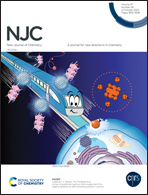Efficient conversion of glucose to 5-hydroxymethylfurfural by multi-functionalized γ-Al2O3 beads
Abstract
CaO-doped γ-Al2O3 beads were prepared by an alginate assisted sol–gel method, followed by grafting with alkyl groups and impregnation of NbCl5 to construct multi-functionalized γ-Al2O3 beads for efficient catalytic conversion of glucose to 5-hydroxymethylfurfural (5-HMF). Doping with CaO improved the binding capacity of the catalyst with glucose and increased the Lewis acid amount. However, a high CaO content would cover the Lewis acid sites of γ-Al2O3, resulting in a lower isomeric conversion of glucose to fructose. When the C8–Ca(10%)–γ-Al2O3 catalyst was loaded with Nb2O5, intermediate fructose was consumed rapidly resulting in complete conversion of glucose, which indicated that conversion of glucose to 5-HMF involved the isomeric conversion of glucose to fructose followed by dehydration of fructose to 5-HMF. This was necessary to balance hydrophilic isomerization reactions with restraining the rehydration of 5-HMF by hydrophobic modification. This is similar to the reaction in which a medium with a certain amount of water was beneficial for glucose isomerization. Under the synergistic effect of Lewis acid provided by γ-Al2O3 and Brønsted acid offered by Nb2O5, C8–Ca(10%)–γ-Al2O3–Nb(3%), a glucose conversation rate of 100% and the highest yield of 5-HMF (68.4%) were achieved in the reaction medium with a dimethylsulfoxide/H2O (V/V) ratio of 4 : 1, a catalyst amount of 33 mg, a reaction temperature of 140 °C and a reaction time of 4 h.



 Please wait while we load your content...
Please wait while we load your content...